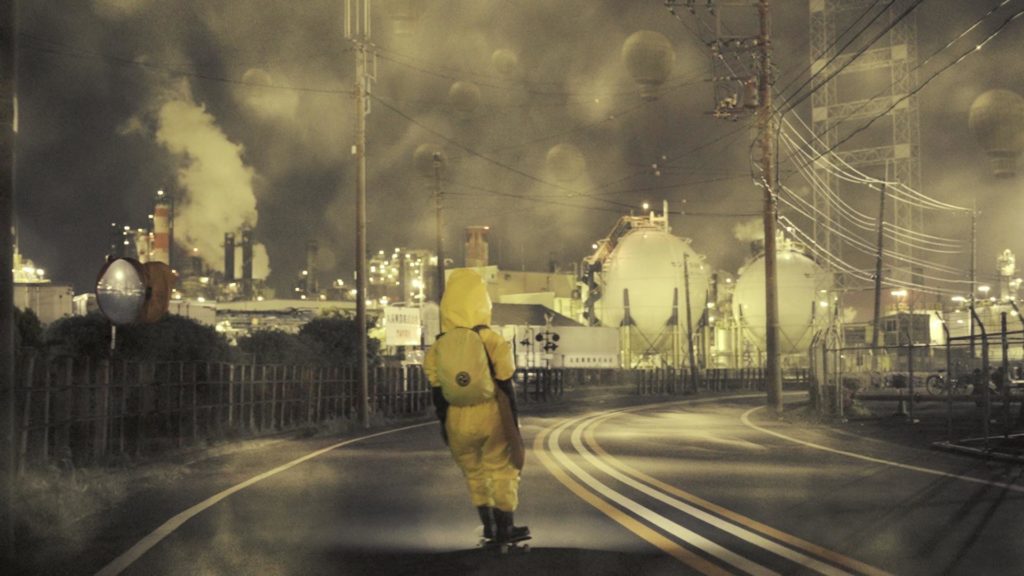How an angsty rock ‘n’ roll record rebels against the Nashville mainstream
by Stewart Slayden
In 2019, American singer songwriter Sturgill Simpson released “SOUND & FURY,” an album featuring ten songs that stunned critics by breaking the boundaries of genres. The Grammy award winning artist drew on country music, synth rock, and funk to create ten unique songs. The goal of the album, Simpson noted, was to make “a sleazy, steamy rock ‘n’ roll record.” Rebelling against the music industry, the album tells the story of the shallowness and cruelty in the music business further highlighted in the accompanying Netflix anime film Sturgill Simpson Presents SOUND & FURY.
The album and film reflect the title through his use of unique instrumentation and violent visuals. The title, which is also the name of a book by an American author William Faulkner, is a reference to Shakespeare’s Macbeth. In an interview by the New York Times, Simpson quotes Macbeth saying “It is a tale told by an idiot, full of sound and fury, signifying nothing.” He continues “I was like, that’s how I feel right now, like, what is all this really for other than making a bunch of strangers happy and trying to let people have fun?” The title’s reference to the cynical story of Macbeth reflects Simpson’s view on the music industry. This view is furthered in his album with his use of rebellious lyrics, instrumentation, and production.
The album’s release comes at an important time in Simpson’s career. The artist, at the peak of his success, turns away from the style of music that got him there. Nashville mainstream wanted him to be the modern traditional country star, a title he rejected. (Simpson protests outside Country Music Awards) After winning a grammy, Sturgill decides to experiment with genre and sing lyrics filled with hateur. He has developed an outlaw character, similar to country artists in the 70’s who also had strong opinions on the Nashville music industry. His shift from classical country to an eclectic rock album is a dramatic one. The album’s rule breaking serves as a powerful message to an industry that often restrains artists’ creativity. Rarely do Nashville artists stray from the simple themes that define country music so Simpson’s departure proves artists can go against the grain. By singing about the greed and restraint in the music industry, he subverts the mainstream and develops a unique point of view.
The album’s opening four minute instrumental track “Ronin,” refers to a samurai without a lord or master during the feudal period of Japan (a reference to the main character of the film). It begins with an audio clip of right-wing radio host Alex Jones announcing “there is an overwhelming body of evidence that supports a conspiracy on the global scale.” Another voice can be heard immediately after saying “the problem with this country is consumption, we consume too much.” Sound effects like footsteps on gravel, a tuning radio, and keys starting a car can be heard in the background. Following the voices, is rolling drums paired with a mid tempo guitar for four minutes. It is a reverb-heavy electric guitar that has a trance-inducing effect on the listener. The post-apocalyptic and dystopian vibe of this track sets the mood for the album and film. The album, which is the background music for the entire film, is mostly rooted in Southern Rock and Country but implements aspects of music from many different genres.
The album characterizes his rebellion with tracks like “Sing Along”, “Last Man Standing”, and “A Good Look” which feature aspects of rock ‘n’ roll such as melodic grooves, guitar feedback and synth riffs. In addition to the instrumentation, the lyrics characterize a disdain for the music industry. For example,“Mercury in Retrograde” tells a story about “journalists” and “haters” and how “living the dream makes a man want to scream / light a match, and burn it all down.” This song is characterized by a psychedelic pulsating melodic beat. The disdain for the music industry being sung over instrumentals that are unique and genre breaking encapsulate the mood of the album. Every song on the album is unique in the way each has a variety of genre characteristics. “Remember to Breathe” features a pulsating electric guitar while a song like “All Said and Done” features psychedelic keyboards and powerful vocals. A song like “Fastest Horse In Town” mixes traditional blues instrumentation with grunge rock and a touch of funk. To the naked ear it is often difficult to make out what Simpson is saying. In “A Good Look” the instrumentation is so loud that it nearly drowns out the vocals, pointing to the message of the album about disdain for the music industry. This represents the idea that opinions can be repressed but time and attention will allow understanding. In addition to his music, the release of an accompanying Anime film furthers his rebellion against the music industry.
Made with Kamikaze Douga animation studio founder Jumpei Mizusaki and Afro Samurai creator Takashi Okazaki, the film loosely tells the story of a female samurai in a muscle car as she seeks out injustice in a post-apocalyptic world. Though classified as Anime there are some live-action scenes, specifically the woman who rides a skateboard through a toxic wasteland. There’s also no dialogue or closed captioning. Instead, the music and the lyrics help tell a story which is closely connected to the album. As suggested by the title the film has a different “episode” for each song largely aligned with the music’s tone and telling a unique story of resistance and anti-conformity. The second “episode” features the track “Remember to Breathe.” Two villains go on a killing spree, one of them, “Mr. Slick,” representing the military industrial complex and violence while the other, Barrister, represents the pharmaceutical industry. An important moment in the plot comes when Mr. Slick kills the black man and Barrister kills the white man– an allegory of the way many people in the United states fall victim to violence, police brutality, or drug addiction.
The film’s forty minutes shift styles very often between violent graphics and other animation styles. Sometimes the viewer is first person, at other times we watch a violent fight, or observe a girl peacefully riding a skateboard through a toxic wasteland. Amid this variety, the film’s references and main themes remain consistent, raising awareness of social and political issues. All in all, the anime film is a warning against authoritarianism and conformity. It ends with a quote by Japanese philosopher Miyamoto Musashi: “Get beyond love and grief and exist for the good of man” and a dedication to “the lost souls and victims of senseless violence.” While this quote seems to contradict forty minutes of violent imagery it affirms defiance against the cruelty in the music industry and desire for good in the world.
An anime film featuring music by a “country” singer may not seem a likely place for social commentary, so Sturgill Simpson tells the story of cruelty in the music business in a unique way. The music on the angsty album rebels, unafraid of being creative and breaking the rules turning SOUND & FURY into a musical middle finger of sorts to all the destructiveness he’s witnessed in Nashville mainstream.




